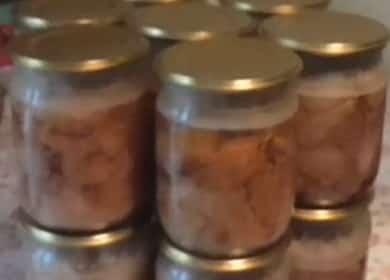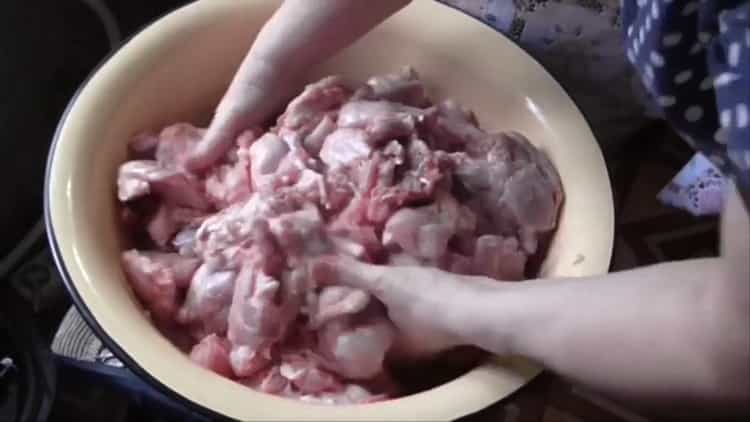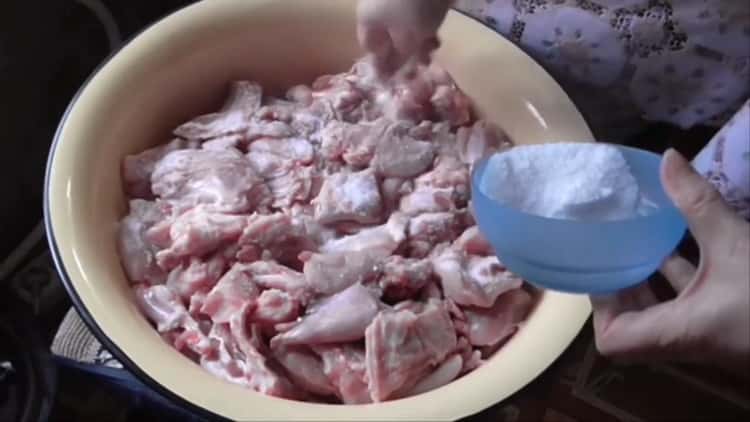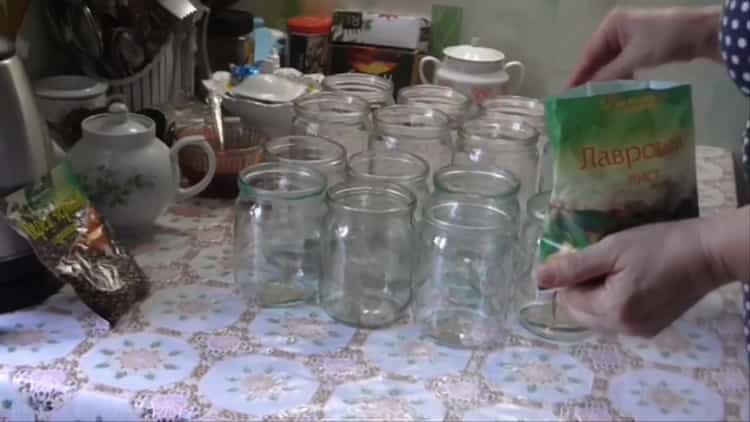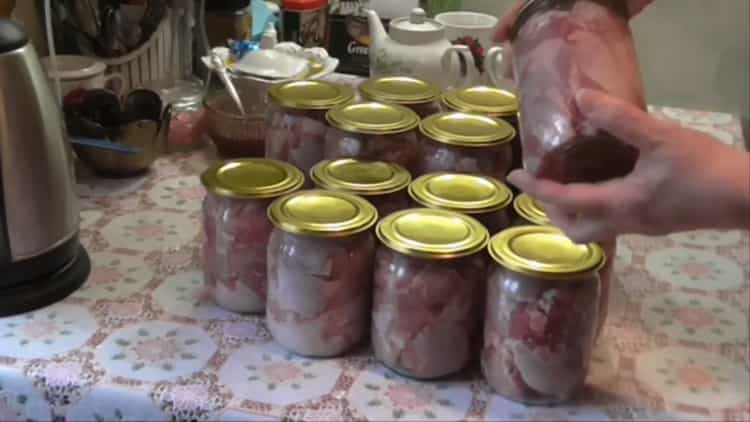Kitchen appliances and utensils: cutting board, knife, basin, 3 pcs. 0.5 liter cans, 3 lids, seaming machine, autoclave or oven, baking sheet.
Ingredients
On three 0.5-liter cans
| rabbit carcass | 1.5-1.7 kg |
| Bay leaf | 3 pcs. |
| black pepper peas | 15 pcs. |
| salt | 18 g |
Step cooking
Can preparation
- Wash with soap or soda, rinse with running water.
- Dry the cans (if desired, you can sterilize them).
- My lids are drying.
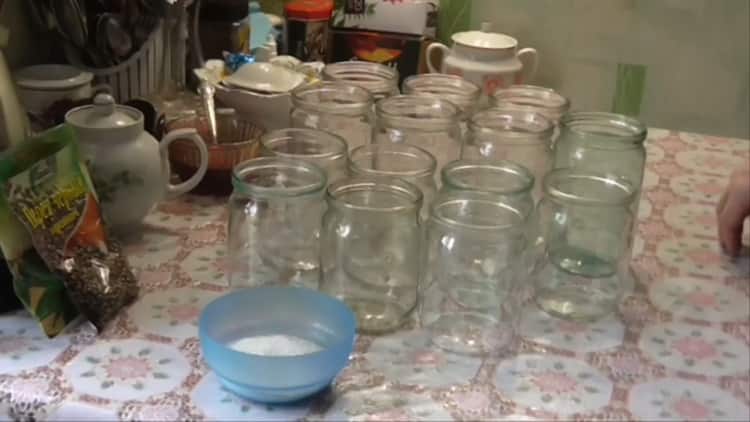
Rabbit preparation
- Wash the whole rabbit carcass, soak overnight (9 hours) in water. Dry, split into parts. Remove, if any, fat (it may be around the neck). Rabbit stew closes with small bones (ribs, paws). Large bones are removed by cutting meat from them. Cut the meat into pieces to fit in a jar. In a large basin we put pieces of a rabbit.

- 1.5 - 1.7 kg of rabbit is placed in three 0.5-liter jars. Pour the meat with salt at the rate of 6 g of salt per one 0.5-liter jar. In the basin, mix the pieces of meat with salt with your hands, if possible, rubbing the salt into pieces. Leave on for 30 minutes to absorb the salt.

Cooking stews (at the same time we cook in three banks)
- In dry banks, put one bay leaf on the bottom. Add 5 peas of black pepper.

- Lay the rabbit. We distribute approximately the same number of pieces in each jar. To keep the voids as small as possible, press down with your hand. Then the meat will lie denser.

- We roll jars of raw meat. We put in an autoclave (if you have it, of course). If there is no autoclave, then we’ll use the oven. We put a baking sheet in a cold oven, put jars on it. We push the cans into the oven, turn it on, and simmer at a temperature of 180 degrees for 1 hour. After 1 hour, reduce the temperature to 100 degrees. Stew for another 5 hours.

- We take out the cans from the oven. The stew is ready.

This is a really good and proven way to cook stews. It can be applied to any kind of meat.
Why soak a rabbit
- You need to soak the meat so that it becomes tender and soft, acquires the aroma of marinade and the spices used.
- So that all odors are neutralized. Domestic rabbits, depending on the content and nutrition, can have a specific smell and taste.
- Helps eliminate bitterness and excessive stiffness. Old meat requires a long soak. But fresh, young rabbit meat should not be soaked so as not to interrupt the natural aroma. For piquancy, you can add a little marinade.
Soaking time
It all depends on the quality of the meat and the desired degree of soaking. Time can vary from several hours to a day or more.
The quality of the flushing depends on how many times you change the water. Usually enough 3-4 times. This method does not particularly affect the taste of the dish, but it well removes bitterness and unpleasant aftertaste. You can pour a few tablespoons of wine, milk, add soy sauce, etc. Do this at the last pour.
In general, rabbit meat can be given any taste with marinades, various spices and sauces.
Rabbit soaking options
- You can soak it in ordinary clean water, milk, a weak solution of vinegar or wine. Correct the time yourself. The result depends on how much time the meat spends in the liquid. For example, when soaking in wine or vinegar, a few hours will suffice, otherwise the meat may be sour.
- When soaked in water, you can add dill, parsley or a couple of drops of lemon.
- If you come across the meat of an old rabbit, you still need to get rid of the smell and unpleasant aftertaste. A great way is to leave it to soak in water with the addition of apple or wine vinegar. For 1 liter of water you need about 1-2 tbsp. l vinegar.
- You can also pour rabbit milk or whey. If soaked in fresh milk, the meat will acquire a sweetish aftertaste. And the acidic environment will allow you to wash everything superfluous, soften the meat and not give a sugary aroma and taste.
- The best way to make a delicious rabbit is to use alcohol for marinade. According to the classic recipe, you need to soak rabbit meat in white wine with spices, but you can also in red dry wine.
Quality control of home canned food
To ensure the good quality of the prepared canned food, the preservation technology provides for exposure of sterilized cans at a temperature of + 37 ... 38 ° C for 10 days. In case of violation of the sterilization regime, microbes may remain in the banks, which will decompose the contents, as a result of the formation of gases, causing lid swelling. This is microbiological bombing. Such canned foods are unsuitable.
If within 10 days there are no violations in the form of smudges of cans and swelling of the lids, this means that the sterilization has been carried out correctly.
Video recipe
In this video you can see how to cook stew from a rabbit. What ingredients were used, in what sequence is cooking.
Other rabbit recipes
Rabbit fricassee with fresh tagliatelle
Rabbit in mustard cream sauce
Rabbit in white wine
Rabbit diet stew
